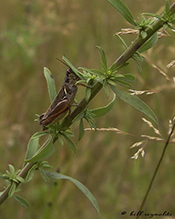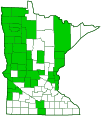migratory grasshopper
(Melanoplus sanguinipes)
Conservation • Description • Habitat • Ecology • Distribution • Taxonomy
|
|
||||||||||||||
Description |
Migratory grasshopper is a common, medium-sized, spur-throated, short-horned grasshopper. It may be the most common species of grasshopper in North American grasslands. It is common in Minnesota. Migratory grasshopper is a serious agricultural pest, causing more crop damage than any other species of grasshopper in North America. Nymphs feed on growing seedlings in cultivated fields in the spring. They are a significant threat to wheat, barley, oats, alfalfa, clover, corn, and vegetable crops. When they migrate in massive swarms they may devastate all leafy vegetation wherever they land. Swarms have been detected at all elevations up to 13,000 feet. They have been recorded traveling as much as 575 miles. Males are 11 ⁄16″ to 15 ⁄16″ long. Females are slightly larger, ¾″ to 1⅛″ long. The overall color is grayish-brown or gray, rarely light green. The upper plate covering the thorax (pronotum) is flat above, not keeled. It is broadly rounded at the tip (posterior) and does not extend over the abdomen. Below, there is a distinct, spiny bump (spur) on the middle section of the thorax between the bases of the forelegs. The abdomen is only slightly swollen at the tip. The sensory appendages at the end of the abdomen (cerci) are robust and are rounded at the tip. They are not constricted in the middle or blackened at the tip. The appendages at the base of the supra-anal plate (furcula) on males are widely spread and short, extending less than half way across the supra-anal plate. The plate on the underside of the tip of the abdomen (subgenital plate) is notched. The wings are long and extend well past the tip of the abdomen when at rest. The front wings (tegmina) are as long or almost as long as the abdomen. They are grayish brown with dark spots and are mostly transparent. The hind wings are clear. On the head there is a narrow, pale yellow stripe behind each eye the continues onto the pronotum and ends abruptly at the hindmost ridge (principle sulcus). The face is vertical. The compound eye is brown with many pale spots. The antennae are brown toward the tip, pale toward the base, and no more than ½ the length of the body. On the hind pair of legs, the narrow upper portion (the outer face) of the hind femur is dull yellow and usually banded. The narrow lower portion (the inner face) of the hind femur is sometimes red. The middle portion of the femur (medial area), the broad area between the outer face and inner face, is grooved in a distinct herringbone or chevron pattern. The banding of the outer face is often carried through on the medial area. The fourth segment (tibia) of the hind leg is usually bluish-green or red, but may be brown, yellow, orange, pink, purple, or gray. On all legs the foot (tarsus) is divided into three segments. |
Size |
Male: 11 ⁄16″ to 15 ⁄16″ Female: ¾″ to 1⅛″ |
Similar Species |
Habitat |
A wide variety of habitats, including prairies, meadows, pastures, abandoned fields, woodland openings, and roadsides. |
Ecology |
Season |
Early July to late September |
Behavior |
As its name implies, the migratory grasshopper congregates into swarms and migrates in search of food. |
Life Cycle |
About six days after mating the female thrusts her ovipositor into the soil at the base of a grass or crop plant and deposits a pod containing 20 to 26 eggs. During the mating season she may mate and lay eggs several times. The eggs hatch in about ten days, depending on the type of the soil, amount of shade, and soil temperature. About 80% of the eggs hatch the year they were deposited. The remaining overwinter and hatch the following year from May to June. After hatching, nymphs undergo five substages of development, shedding their skin each time. They complete the nymphal stage, becoming adults, in 35 to 55 days. |
Nymph Food |
Shoots and other easily digested parts of the same plants that adults feed on. |
Adult Food |
A wide variety of plants (polyphagous), but especially dandelion, tumble mustard, wild mustard, pepperweed, western ragweed, downy brome, Kentucky bluegrass, barley, and wheat . |
Distribution |
||
|
Sources Haarstad, J. 1990. The Acrididae of Minnesota. Final report submitted to the Minnesota Department of Natural Resources. 28 pp. Hebard, Morgan. (1932). The Orthoptera of Minnesota. University of Minnesota. Minnesota Agricultural Experiment Station. Retrieved from the University of Minnesota Digital Conservancy, https://hdl.handle.net/11299/204015. |
|
| 8/12/2025 | ||
Occurrence |
||
Common and widespread |
||
Taxonomy |
|
Order |
Orthoptera (grasshoppers, crickets, and katydids) |
Suborder |
Caelifera (grasshoppers, locusts, and allies) |
Infraorder |
Acrididea (grasshoppers) |
Superfamily |
Acridoidea (short-horned grasshoppers and locusts) |
Family |
Acrididae (short-horned grasshoppers) |
Subfamily |
Melanoplinae (spur-throated grasshoppers) |
Tribe |
Melanoplini |
Genus |
|
Subordinate Taxa |
|
lesser migratory locust (Melanoplus sanguinipes atlanis) migratory grasshopper (Melanoplus sanguinipes defectus) migratory grasshopper (Melanoplus sanguinipes sanguinipes) migratory grasshopper (Melanoplus sanguinipes vulturnus) |
|
Synonyms |
|
Gryllus sanguinipes Melanoplus bilituratus Melanoplus mexicanus |
|
Common Names |
|
lesser grasshopper lesser locust lesser migratory grasshopper migratory grasshopper red-legged grasshopper |
|
Glossary
Cercus
One of a pair of small sensory appendages at the end of the abdomen of many insects and other arthropods. In Odonata, one of the upper claspers. Plural: cerci.
Femur
In insects, the largest, most robust segment of the leg, coming immediately before the tibia. In humans, the thigh bone.
Furcula
In Collembola, a forked, tail-like appendage, attached to the fourth abdominal segment, used for jumping. In Orthoptera, a pair of appendages in a more or less forked position overlying the base of the supra-anal plate.
Pronotum
The exoskeletal plate on the upper side of the first segment of the thorax of an insect.
Subgenital plate
In male Orthoptera, the plate-like structure extending from the lower (ventral) side of the end of the abdomen underlying the genitalia.
Tarsus
On insects, the last two to five subdivisions of the leg, attached to the tibia; the foot. On spiders, the last segment of the leg. Plural: tarsi.
Tegmen
The modified, leathery front wing of some insects that protects the hindwing. It may also serve as a camouflage, a defensive display, or a sound board. Plural: tegmina.
Tibia
The fourth segment of an insect leg, after the femur and before the tarsus (foot). The fifth segment of a spider leg or palp. Plural: tibiae.
Visitor Photos |
||
Share your photo of this insect. |
||
This button not working for you? |
||
Bill Reynolds |
 |
MinnesotaSeasons.com Photos |
||
|
||
|
||

Slideshows |
|

Visitor Videos |
||
Share your video of this insect. |
||
This button not working for you? |
||
|
Other Videos |
||
|

Created: 9/5/2015 Last Updated: © MinnesotaSeasons.com. All rights reserved. |


